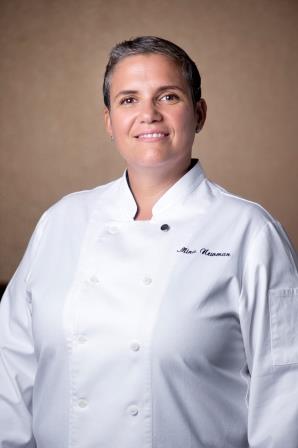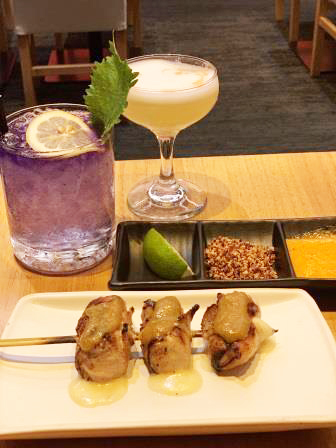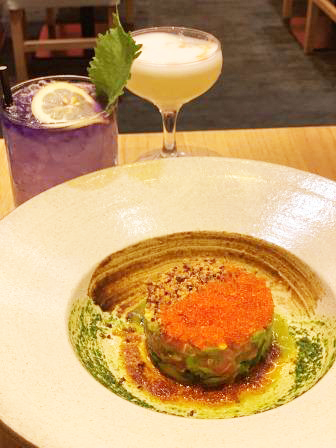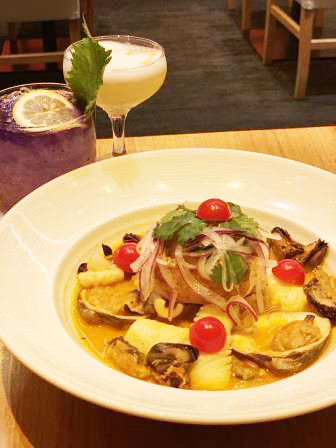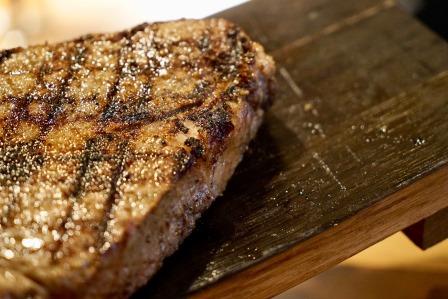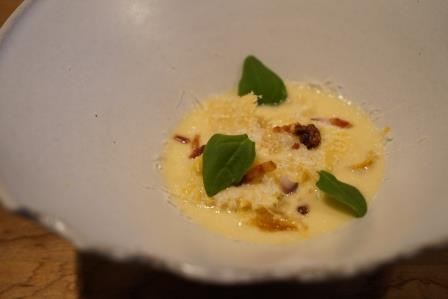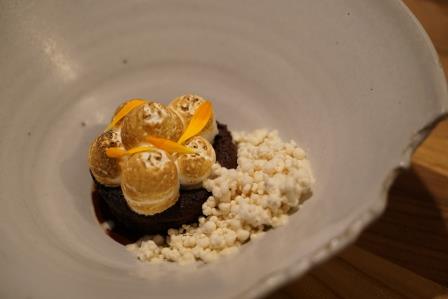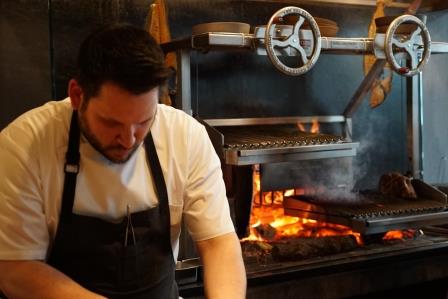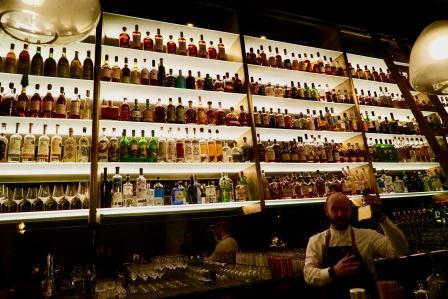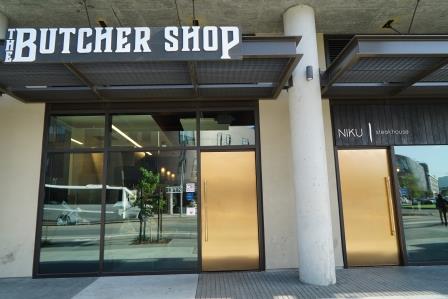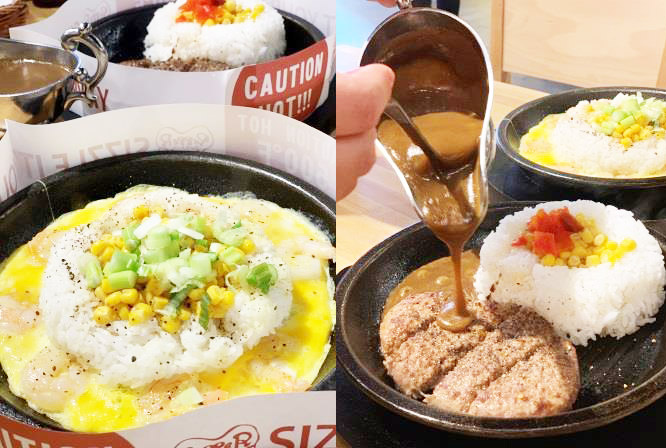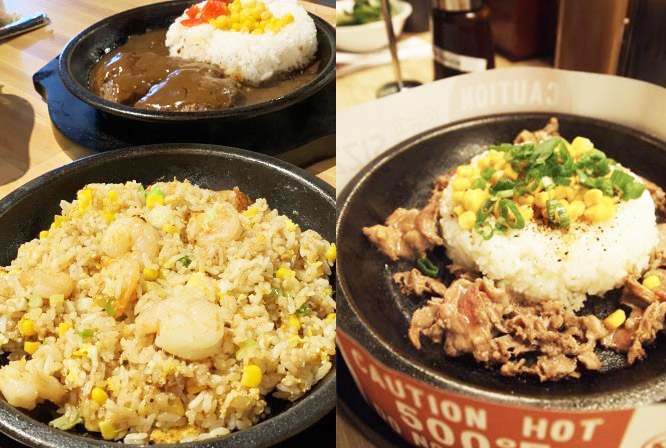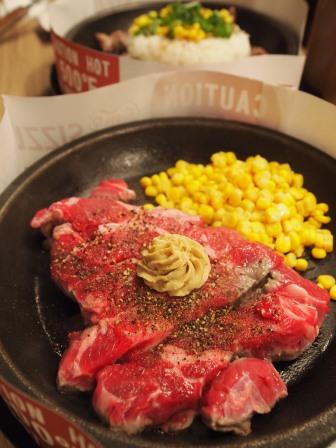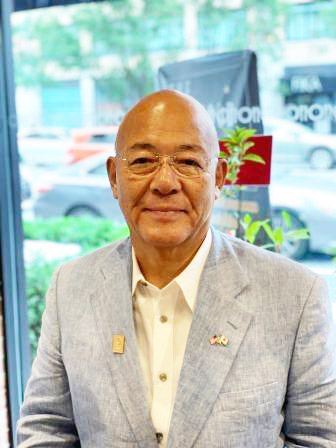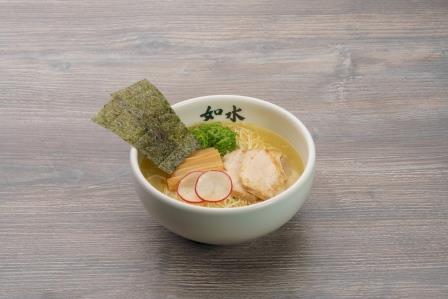New York’s first “Nikkei Cuisine”, a unification of Japan and Peru
By Aya Ota
“Nikkei Cuisine” has been developed by “Nikkei”, the people who immigrated to Peru in the late 1800’s, and their descendants who have been making Japanese dishes using the local ingredients. Peru is a country that is long-stretched from north to south, and embraced by unique geographical and climate conditions neighboring the Pacific coast, Amazon tropical jungle, and Andes Mountain’s high plateau, and the country is naturally blessed with diverse food ingredients. The “Nikkei Cuisine”, which was born through the unification of rich food ingredients and the traditions and techniques of Japanese cuisine, has grown to become not only one of the major food genres in Peru, but has also been demonstrating its fine presence in the world-wide restaurant ranking such as “World’s 50 Best Restaurants”.
The first restaurant which featured this “Nikkei Cuisine” in New York, is “Sen Sakana– Nikkei Kitchen” The name of the restaurant (Sen- Sakana) is derived from Japanese words, which mean 1,000 fish.
“I always try to enlighten our customers about the Nikkei Cuisine,” says Mina Newman, the executive chef. Her mother is Peruvian, and she grew up surrounded by Japanese food ingredients and Nikkei cuisine. During the last 20 years or so, she has been demonstrating her skills at notable New York restaurants which include Mediterranean, Middle Eastern, and steak house restaurants. Her partner chef, who has been demonstrating skills together with her, is Taku Nagai, who was the head chef of the first Ootoya, New York. The menu which has been created by these two chefs of completely different backgrounds has been satisfying gourmet New Yorkers.
Every item on their menu is filled with something new and a surprise. “Buta Queso Cremoso” (Peruvian cheese wrapped in pork belly) looks like yakitori at first, but is made with crispy quinoa, spicy sauce, and lime, which provides enjoyment with different textures. “Halibut Sudado De Mariscos” is a dish that hides ramen underneath its rich-variety of toppings. Its soup, which has been cooked for 6 hours with various seafood, goes well with the custom-made curly noodles. In the “Big Eye Tuna Tartar”, a rhythmic texture has been created by combining tuna and avocado with cucumber pickles, and added quinoa and flying fish roe topping is accentuated by their house-made spicy sesame oil. They use vegetables and fruits which are rarely used in Japanese cuisine, so every bite tasted new to us. However, without being deliberately different, each dish has been cleverly created to give a well-balanced taste. The ratio is different, but the essence of Japanese cuisine such as dashi, soy sauce, miso, seaweed, etc., is contained in every dish. The colorful-ness and fine presentation of each dish is also very impressive.
Newman says, “Our menu has been inspired by the feel of each season.”
The menu gets renewed every 2 months. They also offer a special menu item weekly, featuring seasonal ingredients. She continues, “I also work the hardest to discover new ingredients.” They bring in all sorts of ingredients from both Japan and Peru for testing. Her favorite Japanese ingredient is soy sauce. She says, “It possesses intricate layers, and expanding taste, so we use it as a secret ingredient for many things.” As for drinks, cocktails sell well. Their cocktails stress on Nikkei-unique flavors using Pisco, and shiso or yuzu as an accent.
It is not easy to operate a restaurant of 180 seating in the center of Midtown, and you can see their signs of efforts in many areas. This restaurant is also putting efforts on having private events and catering. They also do not close between lunch and dinner hours, so customers can enjoy lunch until 4pm, which is very well received by business people and tourists. They also offer happy hours between 3 and 7pm. Having various spaces; main dining, bar, counter, and private rooms, can accommodate all sorts of situations.
“Sen Sakana”, which is attracting New Yorkers with their unprecedented innovative concept, makes you feel like you want to keep trying one dish after another.
日本とペルーが融合したニューヨーク初の“日系”料理
1800年代末期、日本からペルーへ移住した移民とその子孫である「日系人」が、現地の食材を使って日本食を作ったことで発展した「日系料理」。ペルーは南北に長く、太平洋沿岸、アマゾン川流域の熱帯雨林やアンデス山脈の高地といった異なる地形や気候を擁することから、多様な食材に恵まれた国だ。その豊かな食材と、和食の伝統や技術が融合して生まれた「日系料理」は、ペルー国内で一大ジャンルとして成長しただけにとどまらず、今や『 World’s 50 Best Restaurants 』をはじめとする世界的なレストラン・ランキングでも存在感を示している。
この「Nikkei」をニューヨークで初めて謳ったレストランが『Sen Sakana– Nikkei Kitchen』だ。日本語で“1000種類の魚介類(one thousand fish)”が店名の由来だ。
「常に客に対して日系料理について啓蒙している」と語るのは、料理長のミナ・ニューマン氏。ペルー人の母を持ち、子供の頃から日本食材や日系料理に触れて育った。これまで20年以上、地中海・中東料理やステーキハウスなど、ニューヨークの数々の名店で腕を振るってきたシェフだ。ニューマン氏のパートナーとして活躍するのは、かつて大戸屋のニューヨーク進出第一号店で料理長を務めた永井択氏。全く異なるキャリアを持つ二人が、アイデアを出し合って創り上げたメニューは、舌の肥えたニューヨークの客をうならせている。
同店のメニューは何を頼んでも、新しい発見と驚きに満ちている。一見、焼き鳥のように見える一品は「Buta Queso Cremoso (Peruvian Cheese Wrapped In Pork Belly)」。クリスピーな食感のキヌアやスパイシーソース、ライムで、味の変化を楽しめる。「Halibut Sudado De Mariscos」は盛りだくさんな具材の下にラーメンが隠されている一品。特製の縮れた太麺に、複数の魚介類を6時間煮込んで作る濃厚なスープがよく合う。「Big Eye Tuna Tartar」はマグロとアボカドにキュウリの漬物を組み合わせリズミカルな食感を生み出し、さらにキヌアとトピッコをトッピングし、アクセントに同店特製のラー油を使った一品だ。日本食では使わないような野菜や果物を駆使し、どれもこれも初めて食べる味。しかし、決して奇をてらうことなく、調和の取れた味を作り出しているのが見事だ。割合はそれぞれ異なるが、どの料理にも、出汁や醤油、味噌や海藻など、日本食のエッセンスが含まれる。色彩や盛り付けの鮮やかさにも目を奪われる。
「メニュー開発のインスピレーションは季節感」とニューマン氏。2カ月に一度は新しいメニューを開発するほか、毎週のように季節の食材を取り入れたスペシャル・メニューを出している。また「食材の発掘に一番力を入れている」と続ける同氏。日本、ペルーの両国から、さまざまな食材を試し、取り入れているという。ニューマン氏が好きな日本食材は醤油。「複雑なレイヤーがあり、味に膨らみがある」ので、さまざまな隠し味として用いている。ドリンクメニューではカクテルが人気。日本酒とピスコを合わせたり、紫蘇や柚をアクセントにしたりと、“日系“色を強く打ち出した内容だ。
ミッドタウンの中心地で席数180もの店舗を運営するのは簡単なことではないが、さまざまな運営の工夫が見られる。同店では、プライベートイベントとケータリングにも力を入れているほか、ランチとディナーの間も休憩なく開店しているのが特徴的で、客は午後4時までランチを楽しむことができるので、ビジネスマンや観光客にも好評だ。また、毎日3〜7時までハッピーアワーも実施している。メインダイニング、バー、カウンター中心のスペース、プライベート・ルームなど多様なスペースがあり、一人でも大勢でも、あらゆるシチュエーションに対応できる。
これまでにない斬新なコンセプトでニューヨーカーを引きつける『Sen Sakana』、次々と違うメニューを試したくなる。
Sen Sakana – Nikkei Kitchen
28 W 44th Street
New York, NY 10036
212-221-9561
https://sensakana.com/
Monday – Friday: 11:30 AM – 10 PM
Saturday: 5 PM – 10 PM
Sunday: Closed
“Nikkei Cuisine” has been developed by “Nikkei”, the people who immigrated to Peru in the late 1800’s, and their descendants who have been making Japanese dishes using the local ingredients. Peru is a country that is long-stretched from north to south, and embraced by unique geographical and climate conditions neighboring the Pacific coast, Amazon tropical jungle, and Andes Mountain’s high plateau, and the country is naturally blessed with diverse food ingredients. The “Nikkei Cuisine”, which was born through the unification of rich food ingredients and the traditions and techniques of Japanese cuisine, has grown to become not only one of the major food genres in Peru, but has also been demonstrating its fine presence in the world-wide restaurant ranking such as “World’s 50 Best Restaurants”.
The first restaurant which featured this “Nikkei Cuisine” in New York, is “Sen Sakana– Nikkei Kitchen” The name of the restaurant (Sen- Sakana) is derived from Japanese words, which mean 1,000 fish.
“I always try to enlighten our customers about the Nikkei Cuisine,” says Mina Newman, the executive chef. Her mother is Peruvian, and she grew up surrounded by Japanese food ingredients and Nikkei cuisine. During the last 20 years or so, she has been demonstrating her skills at notable New York restaurants which include Mediterranean, Middle Eastern, and steak house restaurants. Her partner chef, who has been demonstrating skills together with her, is Taku Nagai, who was the head chef of the first Ootoya, New York. The menu which has been created by these two chefs of completely different backgrounds has been satisfying gourmet New Yorkers.
Every item on their menu is filled with something new and a surprise. “Buta Queso Cremoso” (Peruvian cheese wrapped in pork belly) looks like yakitori at first, but is made with crispy quinoa, spicy sauce, and lime, which provides enjoyment with different textures. “Halibut Sudado De Mariscos” is a dish that hides ramen underneath its rich-variety of toppings. Its soup, which has been cooked for 6 hours with various seafood, goes well with the custom-made curly noodles. In the “Big Eye Tuna Tartar”, a rhythmic texture has been created by combining tuna and avocado with cucumber pickles, and added quinoa and flying fish roe topping is accentuated by their house-made spicy sesame oil. They use vegetables and fruits which are rarely used in Japanese cuisine, so every bite tasted new to us. However, without being deliberately different, each dish has been cleverly created to give a well-balanced taste. The ratio is different, but the essence of Japanese cuisine such as dashi, soy sauce, miso, seaweed, etc., is contained in every dish. The colorful-ness and fine presentation of each dish is also very impressive.
Newman says, “Our menu has been inspired by the feel of each season.”
The menu gets renewed every 2 months. They also offer a special menu item weekly, featuring seasonal ingredients. She continues, “I also work the hardest to discover new ingredients.” They bring in all sorts of ingredients from both Japan and Peru for testing. Her favorite Japanese ingredient is soy sauce. She says, “It possesses intricate layers, and expanding taste, so we use it as a secret ingredient for many things.” As for drinks, cocktails sell well. Their cocktails stress on Nikkei-unique flavors using Pisco, and shiso or yuzu as an accent.
It is not easy to operate a restaurant of 180 seating in the center of Midtown, and you can see their signs of efforts in many areas. This restaurant is also putting efforts on having private events and catering. They also do not close between lunch and dinner hours, so customers can enjoy lunch until 4pm, which is very well received by business people and tourists. They also offer happy hours between 3 and 7pm. Having various spaces; main dining, bar, counter, and private rooms, can accommodate all sorts of situations.
“Sen Sakana”, which is attracting New Yorkers with their unprecedented innovative concept, makes you feel like you want to keep trying one dish after another.
日本とペルーが融合したニューヨーク初の“日系”料理
1800年代末期、日本からペルーへ移住した移民とその子孫である「日系人」が、現地の食材を使って日本食を作ったことで発展した「日系料理」。ペルーは南北に長く、太平洋沿岸、アマゾン川流域の熱帯雨林やアンデス山脈の高地といった異なる地形や気候を擁することから、多様な食材に恵まれた国だ。その豊かな食材と、和食の伝統や技術が融合して生まれた「日系料理」は、ペルー国内で一大ジャンルとして成長しただけにとどまらず、今や『 World’s 50 Best Restaurants 』をはじめとする世界的なレストラン・ランキングでも存在感を示している。
この「Nikkei」をニューヨークで初めて謳ったレストランが『Sen Sakana– Nikkei Kitchen』だ。日本語で“1000種類の魚介類(one thousand fish)”が店名の由来だ。
「常に客に対して日系料理について啓蒙している」と語るのは、料理長のミナ・ニューマン氏。ペルー人の母を持ち、子供の頃から日本食材や日系料理に触れて育った。これまで20年以上、地中海・中東料理やステーキハウスなど、ニューヨークの数々の名店で腕を振るってきたシェフだ。ニューマン氏のパートナーとして活躍するのは、かつて大戸屋のニューヨーク進出第一号店で料理長を務めた永井択氏。全く異なるキャリアを持つ二人が、アイデアを出し合って創り上げたメニューは、舌の肥えたニューヨークの客をうならせている。
同店のメニューは何を頼んでも、新しい発見と驚きに満ちている。一見、焼き鳥のように見える一品は「Buta Queso Cremoso (Peruvian Cheese Wrapped In Pork Belly)」。クリスピーな食感のキヌアやスパイシーソース、ライムで、味の変化を楽しめる。「Halibut Sudado De Mariscos」は盛りだくさんな具材の下にラーメンが隠されている一品。特製の縮れた太麺に、複数の魚介類を6時間煮込んで作る濃厚なスープがよく合う。「Big Eye Tuna Tartar」はマグロとアボカドにキュウリの漬物を組み合わせリズミカルな食感を生み出し、さらにキヌアとトピッコをトッピングし、アクセントに同店特製のラー油を使った一品だ。日本食では使わないような野菜や果物を駆使し、どれもこれも初めて食べる味。しかし、決して奇をてらうことなく、調和の取れた味を作り出しているのが見事だ。割合はそれぞれ異なるが、どの料理にも、出汁や醤油、味噌や海藻など、日本食のエッセンスが含まれる。色彩や盛り付けの鮮やかさにも目を奪われる。
「メニュー開発のインスピレーションは季節感」とニューマン氏。2カ月に一度は新しいメニューを開発するほか、毎週のように季節の食材を取り入れたスペシャル・メニューを出している。また「食材の発掘に一番力を入れている」と続ける同氏。日本、ペルーの両国から、さまざまな食材を試し、取り入れているという。ニューマン氏が好きな日本食材は醤油。「複雑なレイヤーがあり、味に膨らみがある」ので、さまざまな隠し味として用いている。ドリンクメニューではカクテルが人気。日本酒とピスコを合わせたり、紫蘇や柚をアクセントにしたりと、“日系“色を強く打ち出した内容だ。
ミッドタウンの中心地で席数180もの店舗を運営するのは簡単なことではないが、さまざまな運営の工夫が見られる。同店では、プライベートイベントとケータリングにも力を入れているほか、ランチとディナーの間も休憩なく開店しているのが特徴的で、客は午後4時までランチを楽しむことができるので、ビジネスマンや観光客にも好評だ。また、毎日3〜7時までハッピーアワーも実施している。メインダイニング、バー、カウンター中心のスペース、プライベート・ルームなど多様なスペースがあり、一人でも大勢でも、あらゆるシチュエーションに対応できる。
これまでにない斬新なコンセプトでニューヨーカーを引きつける『Sen Sakana』、次々と違うメニューを試したくなる。
Sen Sakana – Nikkei Kitchen
28 W 44th Street
New York, NY 10036
212-221-9561
https://sensakana.com/
Monday – Friday: 11:30 AM – 10 PM
Saturday: 5 PM – 10 PM
Sunday: Closed





